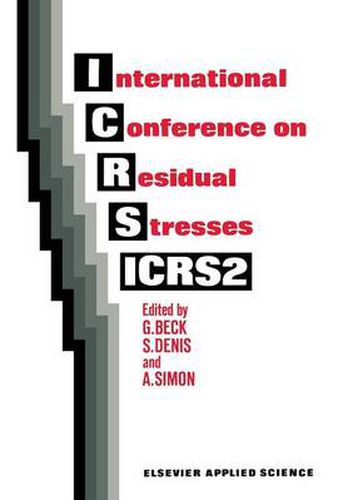Readings Newsletter
Become a Readings Member to make your shopping experience even easier.
Sign in or sign up for free!
You’re not far away from qualifying for FREE standard shipping within Australia
You’ve qualified for FREE standard shipping within Australia
The cart is loading…






This title is printed to order. This book may have been self-published. If so, we cannot guarantee the quality of the content. In the main most books will have gone through the editing process however some may not. We therefore suggest that you be aware of this before ordering this book. If in doubt check either the author or publisher’s details as we are unable to accept any returns unless they are faulty. Please contact us if you have any questions.
Residual stresses are always introduced in materials when they are produced, or when they undergo non-uniform plastic deformation during use. The circumstances that can cause residual stresses are therefore numerous. Residual stresses exist in all materials and, depending on their distribution, can playa beneficial role (for example, compressive surface stress) or have a catastrophic effect, especially on fatigue behaviour and corrosion properties. The subject of residual stresses took form around 1970 with the development of methods to measure macroscopic deformations during the machining of materials or on an atomic scale by X-ray diffraction. These techniques have made considerable progress in the last 20 years. The meetings organized in several countries (Germany, France, Japan, etc. ) have largely contributed to this progress, aided by the numerous exchanges of information and knowledge to which they have given rise. Studies of the formation of residual stresses began more slowly, but have progressed with the emergence of increasingly realistic models of materials behaviour and with access to ever more powerful codes for numerical calculations. Two successive meetings for discussing this topic have been held in Europe. The first, held in 1982 in Nancy (France), consisted of 30 participants from 5 countries. The second was held in Linkoping (Sweden) in 1984, with 80 participants of 16 nationalities. It was decided to hold a first International Conference, ICRS, to address all aspects of the problem. Held in 1986 in Garmisch-Partenkirschen (FRG), it was an assembly of neady 300 participants from 21 countries.
$9.00 standard shipping within Australia
FREE standard shipping within Australia for orders over $100.00
Express & International shipping calculated at checkout
Stock availability can be subject to change without notice. We recommend calling the shop or contacting our online team to check availability of low stock items. Please see our Shopping Online page for more details.
This title is printed to order. This book may have been self-published. If so, we cannot guarantee the quality of the content. In the main most books will have gone through the editing process however some may not. We therefore suggest that you be aware of this before ordering this book. If in doubt check either the author or publisher’s details as we are unable to accept any returns unless they are faulty. Please contact us if you have any questions.
Residual stresses are always introduced in materials when they are produced, or when they undergo non-uniform plastic deformation during use. The circumstances that can cause residual stresses are therefore numerous. Residual stresses exist in all materials and, depending on their distribution, can playa beneficial role (for example, compressive surface stress) or have a catastrophic effect, especially on fatigue behaviour and corrosion properties. The subject of residual stresses took form around 1970 with the development of methods to measure macroscopic deformations during the machining of materials or on an atomic scale by X-ray diffraction. These techniques have made considerable progress in the last 20 years. The meetings organized in several countries (Germany, France, Japan, etc. ) have largely contributed to this progress, aided by the numerous exchanges of information and knowledge to which they have given rise. Studies of the formation of residual stresses began more slowly, but have progressed with the emergence of increasingly realistic models of materials behaviour and with access to ever more powerful codes for numerical calculations. Two successive meetings for discussing this topic have been held in Europe. The first, held in 1982 in Nancy (France), consisted of 30 participants from 5 countries. The second was held in Linkoping (Sweden) in 1984, with 80 participants of 16 nationalities. It was decided to hold a first International Conference, ICRS, to address all aspects of the problem. Held in 1986 in Garmisch-Partenkirschen (FRG), it was an assembly of neady 300 participants from 21 countries.